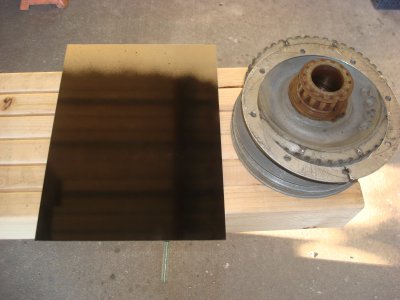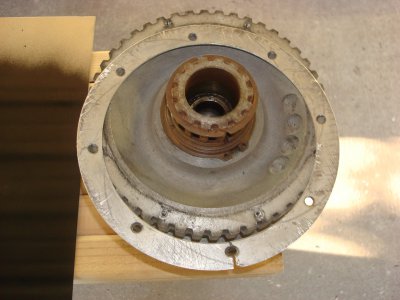Quick way - turn the ring, fit transfer screws[1] in the pulley threads, clamp ring in correct centred position, tap over each transfer screw in turn - voila, eight hole locations prick-punched.
Slow way - measure over pairs of bolts, work out bolt-circle radius,
centre-punch centre of plate and set dividers to radius, scribe hole circle,
straight-edge and scriber, intersecting centre mark and hole circle, scribe first pair of hole locations; centrepunch 'em,
set dividers to 1-1/2 the radius, scribe arcs from the first pair which intersect at 90-degrees from the first pair - lay out scribed line through intersections and centre; centrepunch where the line intersects the bolt circle radius,
same again and again, splitting the 90-degree angles.
For threes and sixes, leave the dividers set to the radius and "walk" them around the circle, giving a mark every 60 degrees (pick alternate marks for three),
For twelve, mark out for six, then set the dividers slightly wider, bisect the 60-degree angles by laying lines from the centre to where the pairs of arcs intersect.
Old Skool, but it works as a last resort

Dave H. (the other one)
[1] Transfer screws:
take a bunch of high-tensile bolts and saw the heads off,
off to the bench grinder with remains (studs) and a cordless drill,
spin studs with drill and put a nice sharp point on 'em.
grind a pair of flats at the pointy end to grip while screwing in or out.
Screw in until just the point's proud of the surface (by 20-40 thou"), tapping the plate will put a nice neat punch=mark in the plate for each transfer-screw point.
This works really well of chuck-to-backplate drillings, lost covers for gearboxes etc. too!
 Guys I need to try and figure out how to lay out 8-8/32 holes to match the SB mill gear.The other 1/16 thick plate mounts to the gear to keep the timing belt from sliding down has broke into and the old holes in the plate is wore out and very loose even when the screws are tight.I can figure out how to cut it into a circle but I am at a lost how to lay out for 8 holes that needs to match the gear.I have painted the plate so that I can see and try to do a good layout.
Guys I need to try and figure out how to lay out 8-8/32 holes to match the SB mill gear.The other 1/16 thick plate mounts to the gear to keep the timing belt from sliding down has broke into and the old holes in the plate is wore out and very loose even when the screws are tight.I can figure out how to cut it into a circle but I am at a lost how to lay out for 8 holes that needs to match the gear.I have painted the plate so that I can see and try to do a good layout.
